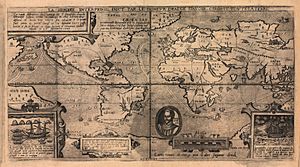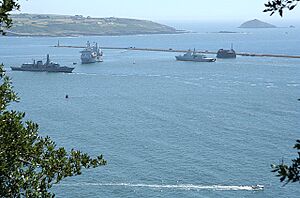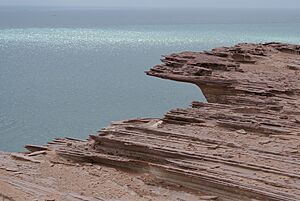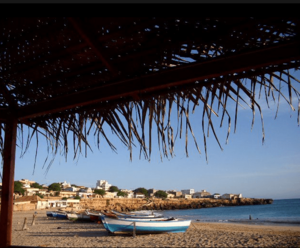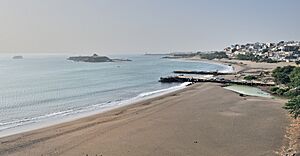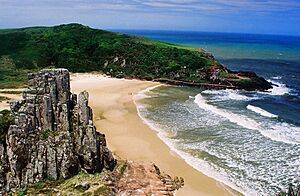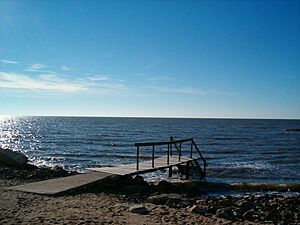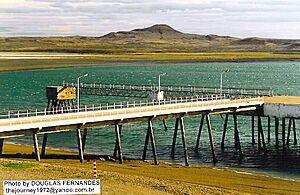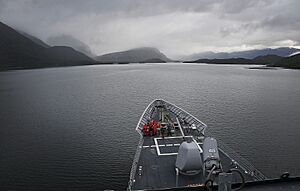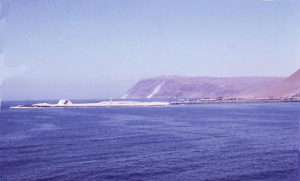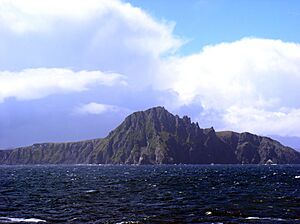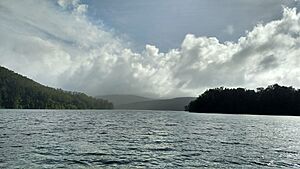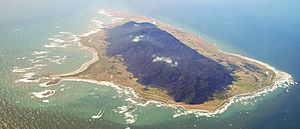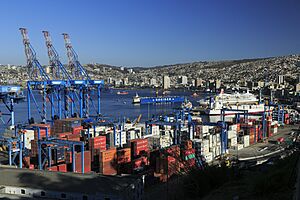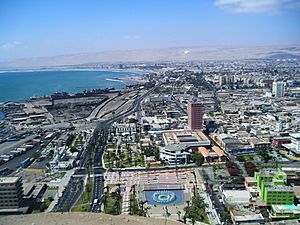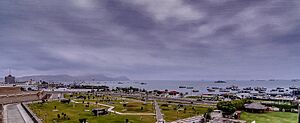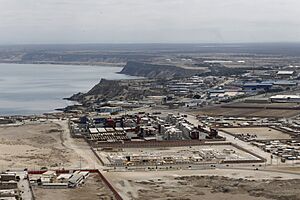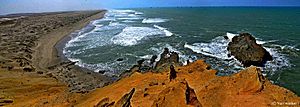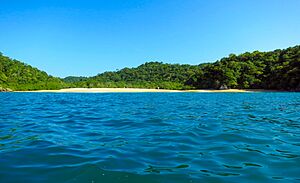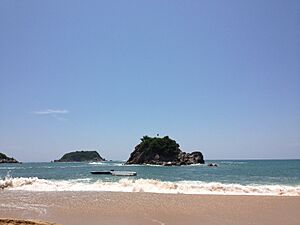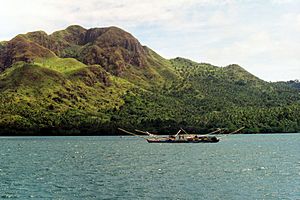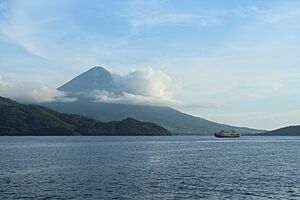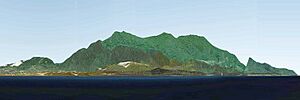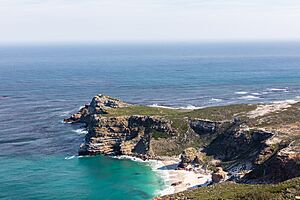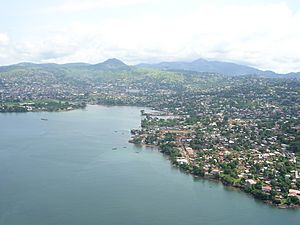Timeline of Francis Drake's circumnavigation facts for kids
In 1577, Francis Drake started an amazing journey around the world. It lasted for 1046 days! Before Drake, only one other expedition, led by Ferdinand Magellan, had managed to sail all the way around the globe. During his voyage, Drake became the first Englishman to sail out of the South Atlantic Ocean. He also claimed the first overseas lands for Queen Elizabeth I of England. When he finished, it was the longest journey humans had ever made at that time.
The idea for this trip came from the competition between Spain and England. Drake thought about taking valuable goods from Spanish ships in the Pacific Ocean. Another person, John Dee, then created a detailed plan for an English journey around the world. After Queen Elizabeth's advisors saw the plan, she met with Drake in 1577. They decided on the details of the voyage. The Queen told Drake to sail through the Strait of Magellan and then north along the coast of Chile. It was also secretly understood that Drake would raid Spanish property. He was supposed to return home the same way he came. During this journey, some English sailors were lost, but Drake's crew did not take any Spanish lives.
Drake sailed from Plymouth Sound, England, into the Atlantic and then the Pacific. He successfully took goods from Spanish ships and towns. He then changed his original plan and sailed even further north, past Chile, to what is now Guatulco, Mexico. The sailing conditions around the Strait of Magellan were very difficult. Also, Drake thought the Spanish might be looking for him along the South American coast. So, he decided not to return the same way. Instead, he sailed north, hoping to find a supposed shortcut called the Strait of Anian. When he couldn't find it, Drake eventually sailed all the way around the world to get home. The expedition returned to England in September 1580 with only one ship, the Golden Hinde. It was full of treasure! The ship's chaplain, Francis Fletcher, and a pilot named Nuño da Silva, both wrote about the journey. Drake's own logbook was lost in a fire in 1698.
Drake's successful trip made him famous as a sailor and explorer across Europe. The treasure he brought back, worth £264,000, was more than the English Parliament collected in a whole year! Because of his amazing achievement, Drake was made a knight. This voyage also led Spain to try and make its defenses stronger. Along with the defeat of the Spanish Armada in 1588, Drake's journey changed the balance of power between countries.
Contents
1577: Starting the Great Adventure
| Date | Location | What Happened | Ref(s) |
| 25 November [O.S. 15 November] 1577 | Plymouth Sound, England | Drake's five ships set sail from Plymouth. This was a false start, though. The ships were the Pelican (Drake's ship), Elizabeth, Marigold, Swan, and Benedict. Drake's brother and cousin were part of the crew.
The ships carried four smaller boats called pinnaces, ready to be put together. There were 164 men and boys on board, including sailors, skilled workers, and gentlemen. Francis Fletcher, the chaplain, kept the most complete diary of the trip. The crew thought they were sailing to Alexandria, Egypt. Different social classes on board would cause problems later on. |
|
|---|---|---|---|
| 16 November – 27 November O.S. | Falmouth, England | A strong storm forced the fleet to find safety here. Even in the harbor, Marigold and Pelican lost their masts. | |
| 28 November – 13 December | Plymouth Sound, England | The ships returned to Plymouth for repairs. Drake fired James Sydae for not supplying the ships well enough. This made Thomas Doughty unhappy, and he complained about Drake's leadership. Doughty also said he had as much power as Drake. After repairs, Drake sailed from Plymouth towards Africa. | |
| 25–31 December | Mogador Island, Morocco | Sailing south along the Moroccan coast, the crew realized they were not going to Alexandria. They anchored for the first time since leaving England and put together a pinnace.
A crewman named John Fry was kidnapped on the island. Drake tried to rescue him but failed. Fry was later released and found his way home on another English ship. |
1578: Across the Atlantic and into the Pacific
| Date | Location | What Happened | Ref(s) |
| 17 January [O.S. 7 January] 1578 | Cape de Guerre, Morocco | Bad winds slowed the fleet. They followed the African coast to Cape de Guerre. They found three Spanish fishing boats. The English sailors used their new pinnace to capture these boats, forcing them to join the fleet. | |
|---|---|---|---|
| 13 January O.S. | Rio del Oro, Morocco | Here, in southern Morocco, Drake let the three fishing boats go. Using the pinnace, they captured a larger ship called a caravel. | |
| 15 January | Cape Barbas, Morocco | Near the tall cliffs of this cape, the Marigold captured another caravel. | |
| 16–21 January | Cape Blanc, Mauritania | The fleet captured a Spanish ship anchored here, whose crew had run away. They entered the harbor, anchored, and went ashore. The crew cleaned their ships and met the local people. The locals offered to sell Drake a woman, but he refused. They also needed water, and Drake simply gave it to them instead of trading.
The English released all captured ships except one, which they exchanged for their small ship Benedict. The new ship was named Christopher. After six days, the expedition sailed for the Cape Verde Islands. |
|
| 28–30 January | Maio, Cape Verde | The fleet anchored west of Maio. Local people salted the wells and ran away. Drake sent John Wynter and Thomas Doughty with 60 men inland to find food and water. A Portuguese pilot, captured at Cape Blanc, led them to the main settlement. | |
| 31 January – 2 February | Santiago, Cape Verde | Drake anchored on the east side of Santiago Island and landed. Following tradition, Drake captured a ship called Santa Maria, despite fire from Maio island. Santa Maria had useful supplies. Drake also took a Portuguese pilot, Nuño da Silva, who had valuable maps. Wynter was worried about being accused of piracy. Drake renamed the ship Mary and put Thomas Doughty in charge. Drake sailed west into the Atlantic with Nuño da Silva, who stayed with the expedition for over a year.
After leaving Cape Verde, Fletcher wrote about the journey ahead, thanking God for keeping them safe to see new parts of the world. While sailing west, a problem arose. Drake had to step in when Doughty argued with his sailors. Drake removed Doughty from command and took over the Mary himself. |
|
| End of February | Fernando de Noronha, Brazil | This marked the end of the expedition's journey across the Atlantic. Nuño da Silva's logbook is the only record mentioning this Brazilian island. With his maps, da Silva knew exactly where the fleet was. | |
| 10 March | Todos os Santos, Brazil | The fleet neared Salvador, a Portuguese settlement in Brazil. Da Silva warned against entering the bay because of Spanish warships. Drake listened, wanting to avoid conflict and keep their presence secret. He continued sailing south along the Brazilian coast. Da Silva was the only one to record this stop. | |
| 5 April | Off the Brazilian coast | Wynter wrote that the fleet reached the Brazilian coast at 31 ½° latitude. He saw flat land with higher areas further inland.
Fletcher recorded their first landing at 33 ½° south latitude on the same day. He said the land looked good for repairing the ships. However, a thick fog stopped them from doing so. |
|
| 6 April | South of 33 ½° south latitude off the Brazilian coast | In this area, the fleet faced a violent storm. It was so strong that the Christopher was lost, and they couldn't land anywhere along the Brazilian coast. | |
| 14 April–8 May | Rio de la Plata at the border of Argentina and Uruguay | Here, a mountain sticking out from the generally flat coast told Drake that fresh water was probably nearby. The fleet anchored near Cape Joy in Rio de la Plata, which is a large bay or estuary. This was their first anchorage after crossing the Atlantic.
The sailors restocked by hunting for meat, taking on water, and gathering wood. The Christopher rejoined the fleet here after being lost in the storm. Drake named the cape "Cape Joy" to celebrate this reunion. The fleet anchored at different spots within the bay. |
|
| 8 May | South of Rio de la Plata in the Atlantic along Argentina's coast | The expedition sailed south, and the Swan quickly got separated. Later, on May 8, a storm cut the Mary from the fleet. Drake's brother Thomas and Nuño da Silva were among the Mary's crew. | |
| 12–15 May | Cape Blanco and Banco Bryon, Argentina | Drake found some sandbanks, Banco Bryon, and anchored there. He was briefly reunited with the Swan. Drake named nearby land Cape Hope. As he took a boat to check the water depth, a thick, misty storm hit. Captain Thomas on the Marigold rescued them. When the ships' anchors started dragging, the fleet headed for open water. The next day was calm, so Drake went ashore to light fires to signal the scattered fleet. All returned safely except the Mary. The crew had friendly meetings with the local people.
Since the land lacked water and wood, the fleet left the harbor on May 15. They sailed slowly, hoping the Mary would catch up. |
|
| May 17–3 June | Nodales Bay (Seal Bay), Argentina | Fletcher wrote that the fleet reached this bay at 47° 30′. Modern studies place it 28 miles south, identifying it as Nodales Bay. After anchoring on May 17, the fleet moved deeper into the harbor and stayed there. During their stay, the crew pulled the Swan ashore and burned it to save its iron parts.
Drake built friendly relationships with the local people using patience and gifts. The two groups met daily, sharing music and dancing. One local person took Drake's red hat. A sailor wanted to shoot him, but Drake said, "not to kill a man for a cap." Drake found it funny and didn't try to get the hat back. On June 3, they sailed south. Here, Drake heard about growing unhappiness. Doughty had argued with John Saracold. Tensions also grew because the gentlemen didn't work as hard as the common sailors. Doughty and a sailor named Gregory had a bitter fight. Doughty then spoke disrespectfully to Captain John Chester. Later, Thomas Doughty and his brother John were ordered onto the Christopher. Thomas refused, so Drake had him forcibly moved. Drake calmed a small protest and returned to the Pelican. The Swan, which was badly damaged, was left behind to keep the fleet together. |
|
| 12–14 June | Cape Blanco, Argentina | Records disagree on this location. Fletcher said the fleet sailed south, but others said Drake sailed north back to Cape Blanco (which Drake had named Cape Hope). The Christopher briefly separated but rejoined Drake here. Drake and his crew were warmly welcomed by the local people and exchanged gifts. The Christopher was unloaded and left behind.
Because the Mary was still missing, Drake believed if he entered the Strait of Magellan without her, they might never see her again. So, he sailed north instead of heading for the strait. |
|
| 17–18 June | Puerto Santa Cruz, Argentina | The fleet anchored at this bay only for a short stop on their way to the next anchorage. | |
| 19 June–17 August | Port San Julian, Argentina | The crew was happy to see this Patagonian port, first used by Magellan. This port, shaped like a figure-eight, has two basins and small islands, making navigation tricky. A damaged, leaking Mary rejoined the fleet on the evening of the 19th. She was later stripped, burned, and left here.
Relations with the local Patagonian people started well but turned tragic. Robert Winterhey, a gentleman, was showing his bow when the string broke. One Patagonian shot an arrow into Winterhey, and another shot a sailor named Oliver. Drake and the other men protected themselves with shields as a general attack began. Drake eventually used a gun and severely wounded the Patagonian who started the violence. This scattered the attackers. Drake did not allow revenge for the two Englishmen's deaths, and the Patagonians did not return. For safety, Drake set up his crew's camp on a small island in the bay. On June 30, all crew members were called to the island. Drake addressed the problems with Doughty by holding a trial for serious crimes. Drake presented the case, and Doughty defended himself. The jury found Doughty guilty and sentenced him to death. On July 2, Doughty was beheaded with dignity. Just before, Drake and Doughty even ate and took communion together. Doughty, Winterhey, and Oliver were all buried on the island, their graves marked with an engraved stone. On another stone, Drake's name was carved in Latin to record his presence. The exact location of the island is not known. Drake then offered the Marigold to anyone who wanted to return to England. Everyone refused. During a Sunday church service, Drake gave a speech, urging the common sailors to stop looking down on the gentlemen, and the gentlemen to work alongside the sailors. Morale slowly improved through July as the men prepared the fleet for the Strait of Magellan. On August 17, the fleet sailed with the three remaining ships: Marigold, Elizabeth, and Pelican. In July 1578, Drake sent Wynter ashore. He learned from the local people that they ate the bark of the Drimys winteri tree. This bark would likely help the Golden Hind and Elizabeth crews avoid scurvy, a disease caused by lack of vitamin C. |
|
| 20 August–6 September | Strait of Magellan, Chile | On August 20, the fleet passed Cape Virgins, which marked the entrance to the straits. They waited two days for good winds to enter the strait. During this pause and at a church service, Drake renamed the Pelican to Golden Hinde to honor Sir Christopher Hatton. Hatton's family symbol included a golden hind. Fletcher wrote, "wee joyfully entered the Straight with hope of good success."
Information about the fleet's passage is mostly from da Silva's and John Drake's accounts. No one in the fleet, not even the Portuguese pilot da Silva, had sailed through these waters before. Anchoring would be difficult. If the ships got separated, all captains knew to meet at 30° south latitude. While currents were helpful, winds changed, and hidden rocks were dangerous. On August 24, they found the islands Isabel, Marta, and Magdalena. Drake and some crew went ashore, claimed the land, and named one Elizabeth Island. Today, it's known as Isabel Island. This was the first time England claimed land overseas for Queen Elizabeth. The fleet anchored five miles west of this claim. At Magdalena, the crew hunted 3,000 penguins. As they continued, anchoring spots remained uncertain. The strait became narrow at Pasa Largo and stayed that way for 40 nautical miles before opening into the Pacific. The three ships left the strait on September 6. Their fourteen-day passage was the fastest of the 16th century. |
|
| 6 September–6 October | Southern Pacific west of Chile | Drake entered the Pacific, thinking Chile curved northwest instead of north. After sailing 70 leagues (about 210 miles) west, the fleet was hit by a storm. After 10 days, it got worse. The Marigold and her 29 crewmen were lost. Captain Wynter later said he had never lived through such a terrible storm. Aboard the Golden Hind, Fletcher and John Brewer heard the cries of the lost sailors. | |
| 7 October | Diego de Almagro Island, Chile | On October 7, the Golden Hinde anchored for only one hour while Wynter stayed close to shore in a deep, dangerous bay. Da Silva recorded this uncertain location at 51°. A storm hit, and the Golden Hinde lost her anchor. This forced the two ships out to sea, pushing them south and separating them.
After the Golden Hinde and Elizabeth were separated, Wynter returned to the Strait of Magellan instead of the Pacific meeting point. He left the fleet, entered the strait on October 8, and eventually anchored in England on June 2, 1579. Fletcher believed Wynter's abandonment was partly due to his commanders' carelessness and partly because the crew wanted to escape the difficult conditions. |
|
| 14 October | Paso Occidental, Chile | Da Silva recorded that the Golden Hinde anchored at 54 1/2° in 50 fathoms of water, three leagues from shore. This is another uncertain location. At this point, Drake's crew was struggling: thirsty, hungry, and needing firewood. They sailed the next day, and Drake was forced further south. | |
| 15 October | Basquet Island, Chile | The ship's crew was carefully checking the depth of a bay at this island. The water had many hidden rocks and small rocky islands. The bay was large, 10 miles long and 8 miles wide. Fletcher said they gathered fresh water and herbs. Before they finished resupplying, another storm hit, and the Golden Hinde dragged her anchors. Drake and the crew showed great skill as they were forced through the dangerous waters and headed out to sea.
Eight crew members, who were in a small boat (pinnace) serving the Golden Hinde, couldn't follow the ship. They eventually sailed back through the strait to the Atlantic. After much hardship, only Peter Carder survived. He eventually returned to England in 1586 and told his story to the Queen. |
|
| 18 October | Cape York Minster, Chile | On the 18th, the Golden Hinde anchored in a bay inside what is now called Cape York Minster. With difficulty, the men landed to get fresh water and firewood. They also briefly talked with the local people in canoes, who traded with the sailors. Another storm hit the Golden Hinde, so violently that she lost her anchor. Drake was again forced to head to open water. | |
| 24–28 October | Horn Island (Elizabeth Island), Chile | Drake anchored in Saint Francis Bay, between Horn Island and Hermite Island. Here, the men rested from the bad weather. The Golden Hinde anchored in 20 fathoms of water. The next day, they landed to gather water, herbs, and firewood. On a day trip, Fletcher used tools to carve Elizabeth's name, her kingdom, and the date onto a stone to mark the Englishmen's presence. The stone has not been found.
Drake explored the island on foot and took measurements at the southernmost part of the island, two miles from the Golden Hinde’s anchorage. Drake named the island Elizabeth Island, even though he had already used that name for a different island in the Strait of Magellan. The crew understood the importance of this anchorage: despite common belief that a large landmass extended from the south of the Strait of Magellan, it was actually a series of islands. They also learned that no strong current stopped ships from sailing east through the strait or where the two oceans met. This discovery went against popular ideas of the time. With good winds, Drake set sail on October 28. Fifty days had passed since the crew first faced storms and violent seas. |
|
| 30 October–1 November | Islas Ildefonso, Chile | Drake anchored here, 72 nautical miles north of Horn Island. Da Silva described the islands as low and small. The crew hunted seal meat and ducks to supply the ship. After leaving, Drake began a 25-day journey of nonstop sailing north. | |
| 24 November | Valdivia River, Chile | According to da Silva and Captain San Juan de Antón (whom Drake later briefly captured), Drake reached the area near the mouth of this river on November 24. | |
| 25-26 November | Mocha Island, Chile | This island, near the Chilean coast, is where Drake anchored. He took about a dozen men ashore. They met the local people, probably Aruacanian people, whom Drake believed were forced from the mainland by Europeans. They gave the Englishmen sheep, hens, and grain, who then returned to the Golden Hinde.
The local people had been aggressive with Spaniards before, so the English should have been careful. But the first day's interactions made Drake less cautious. He returned the next day with 10 men for water, without guns or bows. They only had shields and swords. When they landed, two men got out. The crew was attacked by at least 100 armed Aruacanians. The two sailors, Tom Brewer and Tom Flood, were captured and killed. The boat escaped by cutting its rope, but every Englishman was wounded at least once, and two of them soon died. Drake was shot in the face under his right eye. The death of Diego several months later was blamed on the wounds he got at Mocha Island. Aboard the Golden Hinde, Drake's crew urged him to fire the ship's guns at the Aruacanians. Drake refused. He explained that the Aruacanians were hostile because they mistook the Englishmen for Spaniards, who had treated them badly. Drake wanted his country to avoid such a reputation. Later that day, Drake sailed the Golden Hinde north. |
|
| 30 November | Quintero Bay (Philips Bay), Chile | This bay, named Philips Bay by Drake, was the first time any of the expedition members stepped onto the mainland of Chile. Here they met a local man rowing a canoe made of reeds. He came aboard the ship, was welcomed by Drake, and was grateful for the gifts. This man and several friends returned later with a canoe full of supplies, including hens, eggs, and a fat hog. This wasn't enough for the Golden Hinde crew, so the man offered to guide the ship south to a nearby harbor for more supplies. Fletcher called their guide a "new Indian pilote." | |
| 5-8 December | Valparaiso, Chile | Drake anchored in Valparaiso bay. A small town called Saint James stood along the shore. Here, the Englishmen began taking treasure and supplies from the Spaniards along the Pacific Coast. From the town's warehouses, they took 1,770 jars of wine. They looted the town's nine houses and church. From a Spanish ship also anchored in the harbor, the crew easily took gold, silver, wine, and timber. They got enough bread, bacon, and other food. When leaving the harbor, Drake steered the Golden Hinde north into the Pacific. | |
| 9 December | Along Chile coast north of Valparaiso | Drake let their guide ashore at a spot the guide chose. | |
| 12–14 December | Tongoy Bay, Chile | Here, at 30°, was the meeting point for any lost ships to rejoin the expedition. Low hills surrounded the bay, which had a mile-wide entrance. Drake waited for three days, hoping for the Elizabeth to return, but she didn't. He sent men ashore to look for water, but they found none. Drake left the harbor for the open sea. | |
| 15–16 December | In the Pacific north of Tongoy Bay, Chile | Da Silva recorded that Drake sailed only 6 leagues during this time. On the 17th, he noted that the Golden Hinde "Remained stationary." Drake was waiting in the meeting area, hoping the Elizabeth would rejoin him. | |
| 18–19 December | La Herradura, Chile | Here, Drake anchored across from this 1 ½ mile long cove instead of sailing directly into it. On the morning of the 19th, crew members went ashore to look for water. They took two large pigs and several small ones. At 1:00 that afternoon, they were attacked by Spaniards. Da Silva recorded 250 horsemen, and Fletcher estimated 100. Following the horsemen were 200 local men on foot.
In the attack, Richard Minivy was killed before Drake could arrive with a boat and rescue the others. The crew later returned and buried the body. When they returned to the ship and prepared to sail, Spaniards came back to shore with a flag of truce. Drake did not trust this gesture and left. |
|
| 19 December | Pájaros Rocks, Chile | Shortly after leaving Herradura, the crew tried to sail past these two groups of rocky islands into the port of Coquimbo. The channel was difficult, with strong winds, currents, and waves. While trying to enter the port, Drake barely avoided losing his ship. The damage caused a leak that affected the Golden Hinde for months. | |
| 21 December | Pájaros Islands, Chile | These two tall, steep rocks stood on either side of the channel separating them, 21 miles north of the dangerous rocks Drake met the day before. The crew caught some birds, possibly penguins. But the ship dragged her anchors, and they were forced to sail on after only a brief stay.
Da Silva's log places this anchorage on the 21st. No other record from that time mentions it. |
|
| 20 or 22 December-19 January | Madio Cove at Salada Bay, Chile | The expedition found a convenient, uninhabited cove within Salada Bay. Here they would spend Christmas and celebrate New Year's Day. The crew cleaned and sealed the Golden Hinde’s hull. They also adjusted the ship's balance. The men could catch hundreds of fish a day. Fletcher wrote that this was one of the best places for supplies since they started the voyage.
During this break, the crew unloaded wood from their ship to build a pinnace, which was launched on January 9. The next day, Drake sailed the pinnace south, trying to find the Elizabeth, but it was useless. Fletcher wrote that the pinnace was forced back to harbor after only one day because of "the winde being contrary." Da Silva recorded the pinnace returned on January 12 after being forced back "because natives came from the shore." Fletcher recorded their arrival at this anchorage on December 20, while da Silva recorded December 22. Both recorded January 19 as the day Drake sailed north from this location. |
1579: Raids and Pacific Crossing
| Date | Location | What Happened | Ref(s) |
| Possibly 1 February [O.S. 22 January] 1579 | Pan de Azucar, Chile | From January 22 to January 25, sources disagree on locations and dates.
Here, the crew anchored near an island close to the mainland. This possible location is about 30 miles north of Copiapó, Chile, today. They met four Camanchaca fishermen, invited them aboard the Golden Hinde, and gave them food and gifts. The fishermen said water wasn't easy to find ashore, so Drake continued sailing with the good southerly wind. |
|
|---|---|---|---|
| Possibly 22 January O.S. | Santa Maria Island, Chile | Drake met more fishermen, four in canoes. They guided the Golden Hinde crew to fresh water. | |
| 24 or 25 January | Coloso, Chile | Drake saw three fishermen on the mainland. He took a pinnace ashore and invited the fishermen to board the Golden Hinde. He also took half of the fish he found with them. From this spot, Drake could see mountains to the north, which suggested a fresh water supply. | |
| 4 February | Pisagua, Chile | From the Golden Hinde, crewmembers saw houses near the shore and anchored close by in shallow water. A landing party found and took silver bars from seven llamas.
While looking for water, the crew landed again nearby. Here they found a Spanish man with a local boy. They took more silver from the Spaniard. |
|
| 6–7 February | Arica, Chile | Drake's last stop in Chile was at this port town of about 20 houses. The Englishmen liked the pleasant and fertile area. Two small Spanish ships were anchored and were raided by the English. They took 37 bars of silver and almost 300 jars of wine. A Flemish pilot named Nicolas Jorje, serving on one of the Spanish ships, was taken by Drake. The Englishmen tried to land to search for more goods, but church bells rang the alarm. The threat of armed horsemen sent the Golden Hinde crew back to their ship.
In Arica, Drake learned that a ship in the nearby port of Chule, Peru, was carrying 800 bars of silver. |
|
| 8–9 February | Chule, Peru | A small boat had left Arica to warn Chule about Drake. The Spanish warning worked, and the cargo was unloaded two hours before Drake arrived. The townspeople mocked his failure to get the treasure, shouting, "Go you thief!" Drake managed to take some linen from another ship anchored nearby.
Drake sailed away with some fresh water and the Spanish ship. While still close to shore, Drake set the ship adrift with its sails set. He had lost the element of surprise. Drake took two more pilots. |
|
| 10 February | Sailing along the Peruvian coast north of Chule | Records are unclear about the exact location. On this day, Drake's crew found two Spanish ships. One had nothing valuable to take, the other contained 200 jars of wine. | |
| 15 February | About 12° latitude along the Peruvian coast | With the wind still behind her, the Golden Hinde continued north. About 25 miles before Callao, she met a Spanish ship that Drake stopped. The captain, Gasper Martin, told Drake about two possible valuable ships.
He learned about a ship anchored at Callao, belonging to Miguel Angel, which was taking silver to Panama. Drake was also told that another ship, Nuestra Señora de la Concepción, also known as Cacafuego, had recently left the port. She was a 120-ton ship commanded by Captain San Juan de Antón, who knew nothing about English ships. Since the Spanish ship was heavily loaded with silver and would stop at other ports, Drake believed he could catch her. Drake took two men from the ship and let it go. |
|
| 15 February or 15–16 February | Callao, Peru | Drake arrived at this port for Lima at night. The Golden Hinde hit a sandbar as she sailed through Boquerón Channel. After Drake threatened to hang the pilots he had just taken, the ship moved without more trouble.
The harbor held many ships, from nine to 30, but almost all were empty of crew. As the Golden Hinde was in the harbor, the San Cristobol arrived from Panama and sailed in. A fight for the ship began as Drake's men swarmed aboard. One of Drake's men was shot, and the Spaniards fled to shore in a boat. Drake's crew left the harbor on both ships, the Golden Hinde and the San Cristobol. They carried eight prisoners. Da Silva recorded they left Callao on the 15th, and Fletcher recorded the 16th as their departure day. |
|
| 16 February | Along the northern coast of Callao, Peru | Two Spanish ships, carrying about 300 men, chased Drake. The Nuestra Seńora del Valle was commanded by Trejo, and Pedro de Arana commanded the Nao de Muriles. These ships, which had never faced threats in the Pacific, had no cannons and few firearms. They chased Drake only for a short while and failed to catch him. Drake released the San Cristobol to the eight prisoners and continued up the coast, three days behind the Nuestra Seńora de la Concepción.
After this failure, the viceroy prepared two more ships and a launch to chase the Golden Hinde again. Although ordered to chase as far as Nicaragua, the ships with 120 soldiers, commanded by Pedro Sarmiento de Gamboa, only went to Panama before returning without catching Drake. |
|
| 20 February | Paita, Peru | As the Golden Hinde sailed north, the crew took a ship headed for Lima at Paita. They met no resistance as most of the ship's crew fled by swimming ashore. Drake learned from the captured pilot, Custodio Rodriguez, that he was within two days of catching the Nuestra Seńora de la Concepción. So, Drake continued his pursuit. | |
| 20 February | Punta Pariñas, Peru | Sailing with a strong wind, Drake moved at three to four knots and soon boarded another ship belonging to Gonzálo Alvarez. Even though it carried merchandise, Drake released it. | |
| 28 February | Near the equator off the coast of Ecuador | Drake captured a Panama-bound ship belonging to Benito Diaz Bravo. His crew took gold, silver, ship's gear, and food from the prize. Diaz Bravo estimated these losses at 22,000 pesos. Following his usual practice, Drake freed four Black slaves and offered them jobs on the Golden Hinde at the same pay as the rest of his crew.
Golden Hinde crewmen tested Diaz Bravo's ship to see if it was seaworthy. Drake provided a small boat for Diaz Bravo's crew and told them to move their belongings. Diaz Bravo pleaded with Drake not to take his only property. Drake agreed and returned the ship to its owner. One of the Black seamen told Drake that the ship's clerk, Francisco Jacome, had hidden treasure. When Drake confronted Jacome, he denied it. Not believing him, Drake put a rope around Jacome's neck to make him talk. Drake briefly lifted the clerk from the deck, dropped him into the sea, and then pulled him back with a boat. At this point, Drake was satisfied Jacome was telling the truth and let him go without further harm. Before leaving, Drake had several sails removed from Diaz Bravo's ship and threw them into the sea. This stopped the ship from moving quickly and spreading the alarm that the Golden Hinde was nearby. |
|
| 1–6 March | Cape San Francisco, Ecuador | As the Golden Hinde neared the cape, the crew scanned the sea for the Nuestra Seńora de la Concepción. Drake had offered a gold chain as a prize to whoever saw the ship first. At midday, John Drake spotted her from the crow's-nest. She was sailing four leagues (about 12 miles) away from the Golden Hinde.
To avoid alarming the Nuestra Seńora de la Concepción’s crew by approaching quickly, Drake ordered wine jars to be dragged behind his ship. Nine hours later, the Golden Hinde and a pinnace approached. Drake ordered Antón to lower his sails. Antón refused, and Drake responded with a strong volley of arrows and gunshots. Artillery, firing chainballs, brought down the ship's mizzen mast. Eleven Spanish crew and passengers hid below deck, leaving Antón alone against the English threat. The pinnace hooked alongside the treasure ship, and the English swarmed over it. Antón surrendered and was taken to Drake's cabin, where he was welcomed and treated well. Drake took both ships further out to sea. Over several days, the Spanish treasure was transferred to the Golden Hinde. The haul was huge: 80 pounds of gold, 26 tons of silver, and 13 or 14 chests of reals were taken, along with two casks of water, food, gear, sails, and canvas. This amounted to £126,000, which was half of Queen Elizabeth's yearly income. An additional £4,800 of unregistered cargo was also taken. A young sailor on the ship suggested that the ship should be called Cacaplata (meaning "poop silver") instead of Cacafuego (meaning "poop fire"). Before Antón's passengers and crew were allowed to sail away, Drake personally gave each of them valuable gifts. He gave Antón a safe pass and released the pilot, Jorje. Drake also asked Antón to beg the Viceroy of Peru to spare the lives of the Englishmen captured during John Oxenham's failed expedition. After telling Antón that he would be back in England within six months, Drake sailed the Golden Hinde north. The large amount of treasure made the problem of her leaking hull worse. |
|
| 13-15 March or 16–24 March | Coronado Bay, Caño Island, Costa Rica | Sources disagree on the exact day of arrival at this island off the coast of Costa Rica. At this point, Drake was not in the territory he knew as New Spain. Fletcher and Da Silva suggested there were two anchorages here. The second anchorage was in the southeast corner of Coronado Bay, near a good place to clean the ship. The first was a mile from what is now called River Drake, where sailors found water and wood.
Spanish sailor Pedro Sarmiento de Gamboa noted that even after being cleaned here, the Golden Hinde had a serious leak and needed much sealing. Since the men needed to repair the Golden Hinde, they cleaned the hull of barnacles and collected food, water, and wood. Fletcher noted that they were hit by an earthquake strong enough to shake the ship. Drake used a scouting pinnace and captured another ship, a bark owned by Rodrigo Tello, off the coast of Nicaragua. He put all the prisoners, except one, into the pinnace and exchanged it for Tello's ship. Along with the prisoner, Alonso Sanchez Colchero, he took maps and messages from the Viceroy and King Philip II that were meant for the Philippine governor. He hoped both would help him for his eventual journey across the Pacific. When Drake left the island, he sailed with both ships. |
|
| 4 April | Off the Pacific coast of Guatemala | After sailing along the coast of New Spain since March 30, the Golden Hinde and Tello's bark found another prize this day, an hour before sunrise. Most of the Spanish crew on Don Francisco Zarate's ship were asleep. Drake's crew falsely claimed to be Miguel Angel's ship from Peru, fooling the Spaniards about their identity and easily taking the ship.
Along with silk, linen, food, and water, Drake also took four chests of Chinese porcelain. A Black woman, Maria, also left the ship to travel aboard the Golden Hinde. Drake took another pilot, Jaun Pascual, and left Colchero behind. Since Colchero had refused to cooperate, Drake hoped Pascual would be useful. Later that day, Drake continued north along the coast. Drake was disgusted with the poor condition of Zarate's ship. He threatened to hang the ship's pilot for carrying such a fine gentleman as Zarate on a ruined ship. Before he left Zarate's ship, he gave gifts to each person aboard and gave Zarate a safe pass. Zarate noted the weight and damage the Golden Hind had suffered and thought repairs to the ship were urgent. |
|
| 13–16 April | Guatulco, Mexico | As Drake neared the shore of this settlement, the Spanish pilot assured him it was not defended by soldiers. He quickly took a ship and its goods in the port and cut off its bowsprit and topmasts. Drake freed "three Negroes that had conspired the burning of the towne..." The townspeople hid in the woods as the Englishmen raided the town. They took water, food, and clothing, smashed religious symbols in the church, and removed the bell from its tower. Drake spent most of his time aboard the Golden Hinde, politely entertaining hostages—town leaders—including the alcalde, Gaspar de Vargas.
While anchored, Drake consulted with da Silva over a map as they considered options for returning to England. Da Silva believed Drake would sail north with his two ships to search for the fabled Strait of Anian. Drake released da Silva here after 15 months of forced service. While in the harbor, Drake prepared for open sea sailing by taking down his cannons and sealing the gun ports by closing and sealing them. |
|
| 16 April–4 June | In the Pacific west of Guatulco | Drake was briefly stuck without wind when he left the harbor. He eventually sailed 500 leagues (about 1500 miles) west into the Pacific until he caught the northeast trade winds. Sources from that time say Drake then sailed to either the 48th or 42nd parallel before turning towards land and following the coast southward. Cold weather stopped him from going further north. | |
| 5 June | South Cove at Cape Arago, Oregon | Strong winds forced Drake to sail towards shore and seek shelter for his two ships in what Fletcher called "a bad bay." They did not land. Drake realized the Strait of Anian had escaped him and knew he had to sail around the world to get home. Drake decided to find a safe harbor to clean and repair the Golden Hinde for the journey across the Pacific. He steered south along the coast. | |
| 17 June–23 July | Drakes Bay and Drake's Cove near Point Reyes, California | Near 38° latitude, Fletcher wrote that "it pleased God to send us into a faire and good Baye with a goode winde to enter the same." While anchored in the bay, the crew first met a lone man in a canoe and exchanged gifts. He was from the Coast Miwok people, and this was their first meeting with Europeans. The ships moved from the bay into what is now Drakes Estero and anchored in Drake's Cove. The crew set up camp and cleaned the Golden Hinde to prepare her for sailing across the Pacific.
The crewmen were visited by a large group of Coast Miwok who held a ceremony. They gave speeches and placed a feathered crown on Drake's head. Later, Drake had a brass plate made that named the land Nova Albion (New Albion) and claimed the region for his queen. Drake chose this name for two reasons: first, the white banks and cliffs looked like those on the English coast, and second, because Albion was an old name for Great Britain. During this stay, Drake hiked inland to visit a Coast Miwok village. Fletcher noted the striking difference between the pleasant inland area and the cold, foggy shoreline where the men's camp was. Fletcher also recorded details about the people, homes, baskets, and language, as well as detailed descriptions of the plants and animals. All interactions between the Coast Miwok and Englishmen were friendly. The Coast Miwok showed sadness as the Golden Hinde sailed into the Pacific over a month after first arriving here. Drake left Tello's bark and Chinese porcelain behind. |
|
| July 24 | Farallon Islands, California | The next day, Drake landed at these California islands southwest of Drake's Bay, and he named them the Islands of Saint James. The Golden Hinde anchored while the crew caught seals and birds for food before they began their Pacific crossing. | |
| 30 September–3 October | Palau, Caroline Islands | Drake anchored at Palau Island in the Caroline Islands, which is now part of Micronesia. He had been at sea for 68 days without seeing land.
Many people arrived in canoes and swarmed the ship. After a short period of trading, they started taking what they wanted and fighting among themselves. Golden Hinde sailors got the people off the ship, but then they were attacked with darts and arrows. After one warning shot that didn't work, Drake reluctantly ordered artillery fire into the group. This damaged canoes and injured people, scattering the survivors. The Englishmen named this the Island of Thieves and sailed on. Fletcher wrote, "Till the third of October wee could not get cleare of these consorts." |
|
| 16–21 October | Mindanao, Philippines | Drake landed at four islands that the Golden Hinde sailed along until October 21. They anchored to search for water at the largest, Mindanao. This was the first time his crew had landed since leaving California, three months earlier. | |
| 23 October | Sarangani Islands | South of Mindanao, the Golden Hinde sailed between two islands and was approached by men in two canoes. The two groups wanted to talk, but strong winds pushed the Golden Hinde south towards the Indonesian Islands. | |
| 24 October | Louisa Bank, Indonesia | While sailing near these banks, Drake saw a Portuguese ship he hoped to capture. Seeing this, the ship sailed into shallow water, and Drake decided not to chase it. | |
| 25 October | Sangi and Siau Islands, Indonesia in the Celebes Sea | Between these two islands, Drake met two fishermen who lived on Siau. He hired them to guide the Golden Hinde through Siau Passage to the Moluccas. | |
| 2 November | Suaro Island, Indonesia | Fletcher noted that from this point, they had sighted their desired destination: the Moluccas. | |
| 3–9 November | Ternate, Moluccas | In this group of islands, Drake found the Sultan of Ternate eager to trade with the English for political reasons. The Sultan, Babu, who controlled most of the clove trade, sent three large boats to formally greet Drake and tow the Golden Hinde to its anchorage. As the Sultan's boat approached, Drake fired a gun salute, and the two boats joined.
They made a serious verbal agreement. Drake promised English ships to the Sultan within two years. The Sultan offered the clove trade to Queen Elizabeth, and the two men exchanged valuable gifts. The Golden Hinde was loaded with six tons of cloves and sailed west. |
|
| 14 November – 12 December | Little island southward of Celebes | Fletcher called this location a "little iland" at "1 deg. 40 min. toward the pole anartike." Historian John Sugden places the island in the Banggai Archipelago, and Turner identifies it as Potil Island.
Even though it was uninhabited, it was a pleasant, wooded place with plenty of water and food. Those who were sick recovered quickly. Again, Fletcher recorded details of the plants and animals. The crew cleaned the Golden Hinde and prepared to leave these waters and cross the Indian Ocean. In his statement to the Inquisition, John Drake said that Maria and three Black men were left on the island "to found a settlement, leaving them rice, seeds and means of making fire." Another source from that time said the woman was simply left on the island. |
1580: Homeward Bound
| Date | Location | What Happened | Ref(s) |
| 19-20 January [O.S. 9-10 January] 1580 | Vesuvius Reef | After sailing west through the Kaloembangan Strait, Drake entered the most dangerous area of shallow waters and narrow passages he had seen on this voyage. After successfully navigating through the dangerous waters, in the darkness of 8:00 that night, Drake ran the Golden Hinde onto a reef where she got stuck. A strong wind tilted her to one side and held her tight. While various places have been suggested for this uncertain location, most recent studies identify it as Vesuvius Reef. Fletcher recorded the location as one or two minutes shy of two degrees south latitude, and he wrote that this was the expedition's greatest danger.
Before pumping water from the hold, Drake first called the men to kneel and pray. Soon, it was clear the ship's wooden frame was solid. Drake tried to pull the ship off the reef using anchors. This is when they learned how sharply the reef rose from the sea floor: only a boat length from the ship, sailors measured 300 fathoms (about 1800 feet) and couldn't find the bottom. Pulling the ship off was impossible. The Englishmen decided to lighten the ship so she could float higher in the water. Cannons, spices, and food were among the items thrown overboard. At 4:00 on the afternoon of January 10, the wind lessened, and the Golden Hinde came free from the reef. The only damage was a small leak. At one point during the problem, Fletcher preached that their trouble was God's anger because Drake had executed Doughty. After the ship was freed, Drake angrily punished Fletcher, chained him to a hatch, and hung a sign on him that said: "Frances fletcher, ye falseth knave that liveth." |
|
|---|---|---|---|
| 14 January O.S. | Wowoni Island, Indonesia | The crew spent the day anchored at this island to gather wood and water. | |
| 26 January–February 6 | In the seas southwest of Celebes | Almost a week after clearing Celebes, the Golden Hinde was met with westerly storms that constantly pushed her east into the Banda Sea. The crew saw islands and looked for anchorages, but none were possible until they landed at Damar Island. | |
| 6–10 February | Damar Island, Indonesia | On the second day after the crew spotted five islands, they anchored at the largest and went ashore to collect water and wood. While sailing from this anchorage two days later, they were met by people in canoes who invited Drake's crew to their town. Drake anchored, and crewmembers visited the town. Fletcher, who spelled Indonesian names as they sounded, recorded the town's name as Baratiua. Turner identifies it as modern-day Bebar at Damar Island's other main anchorage.
The Englishmen found the island to be rich in metals like gold, silver, copper, and tin, which the people worked into various shapes. There was much fresh food and spices, including nutmeg, pepper, ginger, lemons, figs, and cucumbers. Fletcher was impressed with the inhabitants' good looks, polite behavior, and kindness to strangers. He described the clothing of both the men and women. Other than Ternate, the Golden Hinde’s crew found this to be their most comfortable and refreshing stay. |
|
| 10–17 February | Among Indonesian Islands between Damar and Rusa | With the winds now favorable, Drake was able to continue his journey home. The Golden Hinde passed several islands. On the 12th, near 8° 4’ latitude, Drake passed along the northern shores of the islands Moa, Leti, and Kisar. Fletcher recorded that on the 14th and 16th, they passed by more islands at 9° 40’. Since no islands exist there, Aker identifies these islands as those at 8° 40’. This means Drake passed Atauro and Liran on the 14th, and Alor, Kisar, Pantar and Batan on the 16th. He then went through the Alor Strait and steered for his next anchorage. | |
| 18-19 February | Rusa Island, Indonesia | Drake anchored his ship at this small island where they could get firewood. The only food they could find was two turtles. | |
| 9-26 March | Cilacap, Java | Drake sailed the Golden Hinde to the south of Java to avoid the Portuguese, who controlled the Malacca Strait and might have been as far as 50 miles south of the island. By going to the south coast of the island, he confirmed that it was indeed an island and not part of the supposed continent Terra Australis. He would anchor at three different locations on the island.
On the 10th, Drake anchored on a shallow area two miles off the coast. On the 11th, he moved the ship to the island's northeast sheltered shore and into a cove near a town where he anchored and took water. Drake sent a boat ashore to meet the Java inhabitants and moved the Golden Hinde once more, closer to the town. On the 12th, Drake sent men ashore with gifts of linen, wool, and silk cloth, which the king received well. In return, the king sent rice, hens, and other food. Fletcher wrote about the political leaders and noted the happy visits and exchanges the Englishmen had with the people of Java. Drake happily entertained them, and Fletcher noted that they particularly enjoyed the Golden Hinde’s musicians. Fletcher also wrote that the Java music was "of a very strange kind, yet the sound was pleasant and delightfull." These visits and exchanges delayed the crew from doing much-needed maintenance on their ship. Her hull had collected so many shellfish that her sailing was greatly slowed. Finally, Drake either grounded or cleaned the ship for repairs. This was a crucial stop for Drake. From here, he would be at sea for months before his next landing. |
|
| 21 May | East African coast | Fletcher recorded that since leaving Java on March 26 and sailing west-southwest towards the Cape of Good Hope, the crew had been "without touch and ought, but aire and water, till the 21 of May, when we espied land (to wit, a part of the maine of Africa), in some places very high, under the latitude of 31 deg, and halfe." | |
| 2 June | Plymouth Sound, England | After leaving the expedition in October 1578 at the Strait of Magellan, John Wynter and his crew arrived back in England aboard the Elizabeth. | |
| 15 June | Cape of Good Hope, South Africa | The Golden Hinde sailed so close to the cape that it was within range of her guns. Drake sailed around the cape without stopping. | |
| 15 July | Cestos River, Liberia | The Golden Hinde landed at the mouth of the river, where there were many fishermen in their boats. The fishermen came near the English ship, but she sailed on without any interaction between the two groups of people. | |
| 22 July | White Man's Bay, Freetown, Sierra Leone | Drake and his crew had completed a 9,700-mile journey from Java to Sierra Leone. The water supply was critically low, with only one pint for every three men. John Drake believed that only two or three more days without water would result in crewmen's deaths.
Here, the Golden Hinde crewmen were able to take aboard the desperately needed water and fresh fruit. Here, too, the Englishmen saw elephants. To clean the ship's hull, the crew tilted her without fully cleaning the vessel. This allowed most, but not all, of the hull to be cleaned. |
|
| 26-28 September | Plymouth Sound, England | After 1046 days away from England, Drake was careful as he entered English waters. He knew it was possible that he was no longer in favor, as the political situation might have changed during his voyage. So, as the Golden Hinde sailed off Rame Head and headed into Plymouth Sound, Drake hailed a fisherman and asked, "Is the queen alive and well?"
Being discreet, he anchored on Saint Nicholas Island's seaward side so his ship was hidden from the city. Drake sent John Brewer to Sir Christopher Hatton with the news of the Golden Hinde’s return. Brewer would return three days later with Queen Elizabeth's assurance that Drake had nothing to fear. Fletcher summarized the voyage at its end as "seeing the wonders of the Lord in the deep, in discouering so many admirable things, in going through with so many strange aduentures, in escaping out of so many dangers, and ouercomming so many difficulties in this our encompassing of this neather globe, and passing round about the world, which we haue related." |
Images for kids


